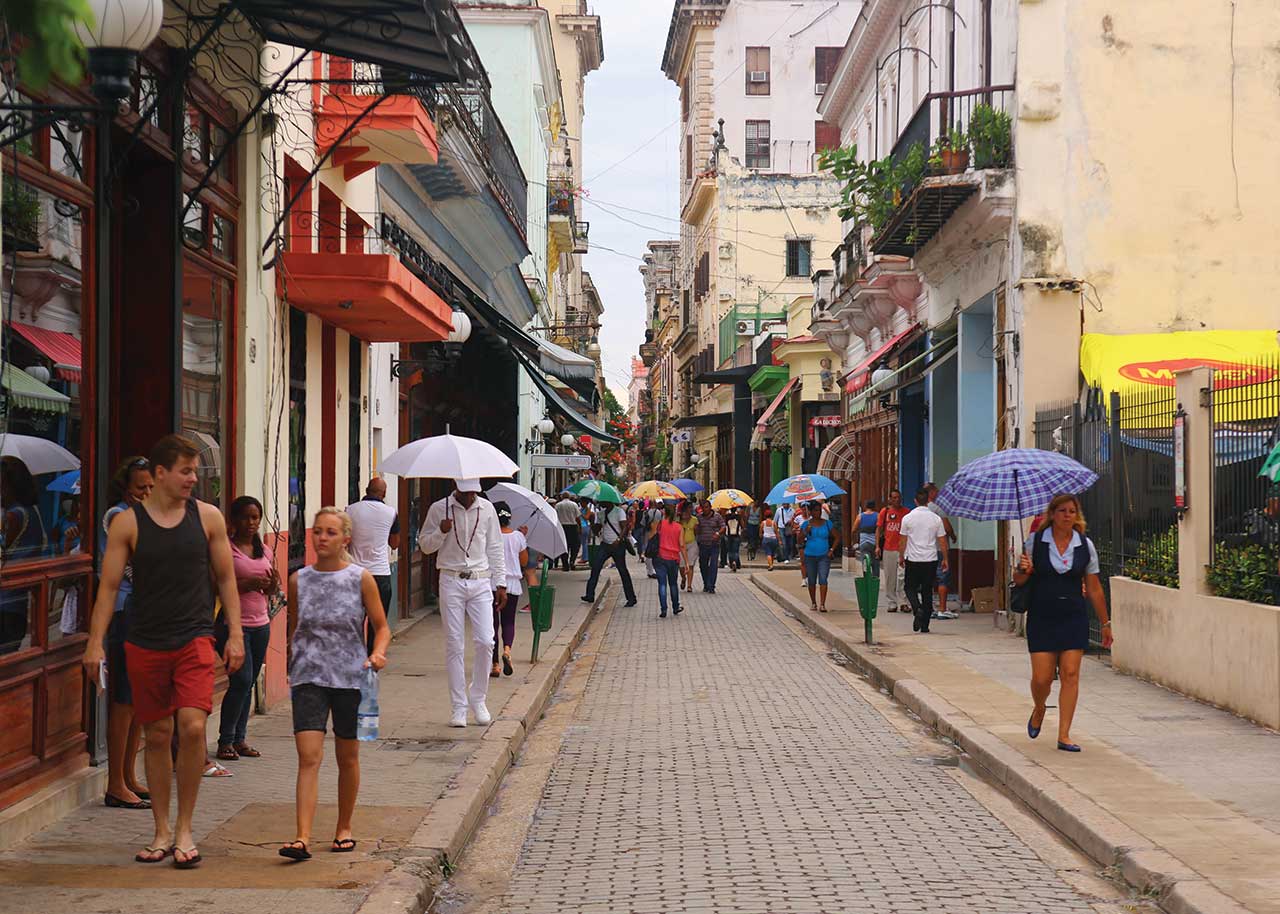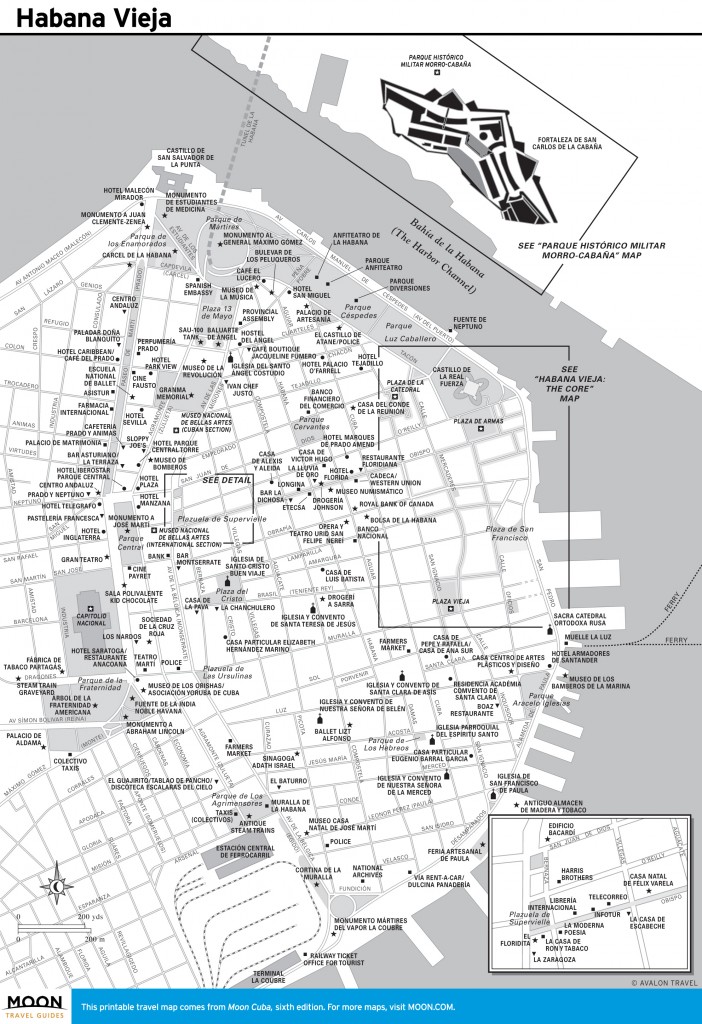Linking Plaza de Armas with Parque Central, pedestrians-only Calle Obispo is Habana Vieja’s busiest shopping street and a fascinating walking tour steeped in history. You’ll have the opportunity to visit half a dozen museums and historical sites, including one of Hemingway’s old haunts and a truly ancient apothecary, as well as tour beautifully preserved and restored architecture. This walking tour begins in Plaza Albear and takes you all the way through to Plaza de Armas, stopping at all the sights along the way.
Hemingway’s quarters have been preserved, with furnishings from his home, Finca Vigía, including his typewriter.From Plaza Albear, walk east. Fifty meters on your left you’ll pass the Infotur office. Crossing Calle Havana, five blocks east of Plaza Albear, you arrive at Havana’s erstwhile “Wall Street,” centered on Calles Obispo, Cuba, and Aguiar, where the main banks were concentrated prior to the Revolution. The Museo Numismático (Coin Museum, Obispo, e/ Habana y Aguiar, tel. 07/861-5811, Tues.-Sat. 9am-4:45pm, Sun. 9:30am-5pm, CUC1) displays a broad-ranging collection of coins and banknotes spanning the Greco, Roman, and Phoenician epochs, as well as Spanish coins plus Cuban money from the republican era. Across the street is the Museo 28 de Septiembre (Obispo #310, tel. 07/864-3253, daily 9am-5:30pm, CUC2), a dour museum telling the history of the Committees for the Defense of the Revolution.
Pedestrians walking along Calle Obispo. Photo © Christopher P. Baker.
Continue one block to Drogería Johnson (Obispo #361, tel. 7/862-3057, daily 9am-5pm), an ancient apothecary that still operates as a pharmacy.
At the corner of Calle Cuba you reach the former Banco Nacional de Cuba (Obispo #211, esq. Cuba), in a splendid neoclassical building fronted by fluted Corinthian columns; it is occupied by the Ministerio de Finanzas y Precios (Ministry of Finance and Prices). Beyond, don’t miss the Museo y Farmacia Taquechel (Obispo #155, esq. Aguiar, tel. 07/862-9286, daily 9am-6pm, free), another fascinating and dusty old apothecary with mixing vases, mortars and pestles, and colorful ceramic jars full of herbs and potions.
Across the street, on the north side of Obispo, is the Edificio Santo Domingo, a looming contemporary building occupying the site of the Convento de Santo Domingo, which between 1727 and 1902 housed the original University of Havana. The building has been remodeled with a replica of the original baroque doorway and campanile containing the original bell. The building today houses the Museo de la Universidad (Calle O’Reilly, no tel., Tues.-Sat. 9:30am-5pm, Sun. 9:30am-1pm), displaying miscellany related to the early university.
Fifty meters beyond Museo y Farmacia Taquechel you’ll arrive at the rose-pink Hotel Ambos Mundos (Obispo #153, esq. Mercaderes, tel. 07/860-9530), dating from 1925. Off and on throughout the 1930s, Hemingway laid his head in room 511, where he wrote The Green Hills of Africa and Death in the Afternoon. The room is today a museum (daily 10am-5pm, CUC2). Hemingway’s quarters have been preserved, with furnishings from his home, Finca Vigía, including his typewriter.
One block farther brings you to a 50-meter-long cobbled pedestrian section and the oldest mansion in Havana: The Casa del Agua la Tinaja (Obispo #111) sells mineral water (CUC0.25 a glass). The Museo de la Orfebrería (Museum of Silverwork, Obispo #113, tel. 07/863-9861, Tues.-Sat. 9:30am-5pm, Sun. 9:30am-1pm, free) is crammed with silver and gold ornaments from the colonial era, including a splendid collection of swords and firearms. Next door, the Museo de Pintura Mural (Painted Mural Museum, Obispo #119, tel. 07/864-2354, Tues.-Sat. 9:30am-5:30pm, Sun. 9:30am-1pm), displays colonial murals, plus a quitrin (traditional low-slung, horse-drawn cart of the colonial nobility).
Another 50 meters brings you to Plaza de Armas.

Habana Vieja
Excerpted from the First Edition of Moon Havana.